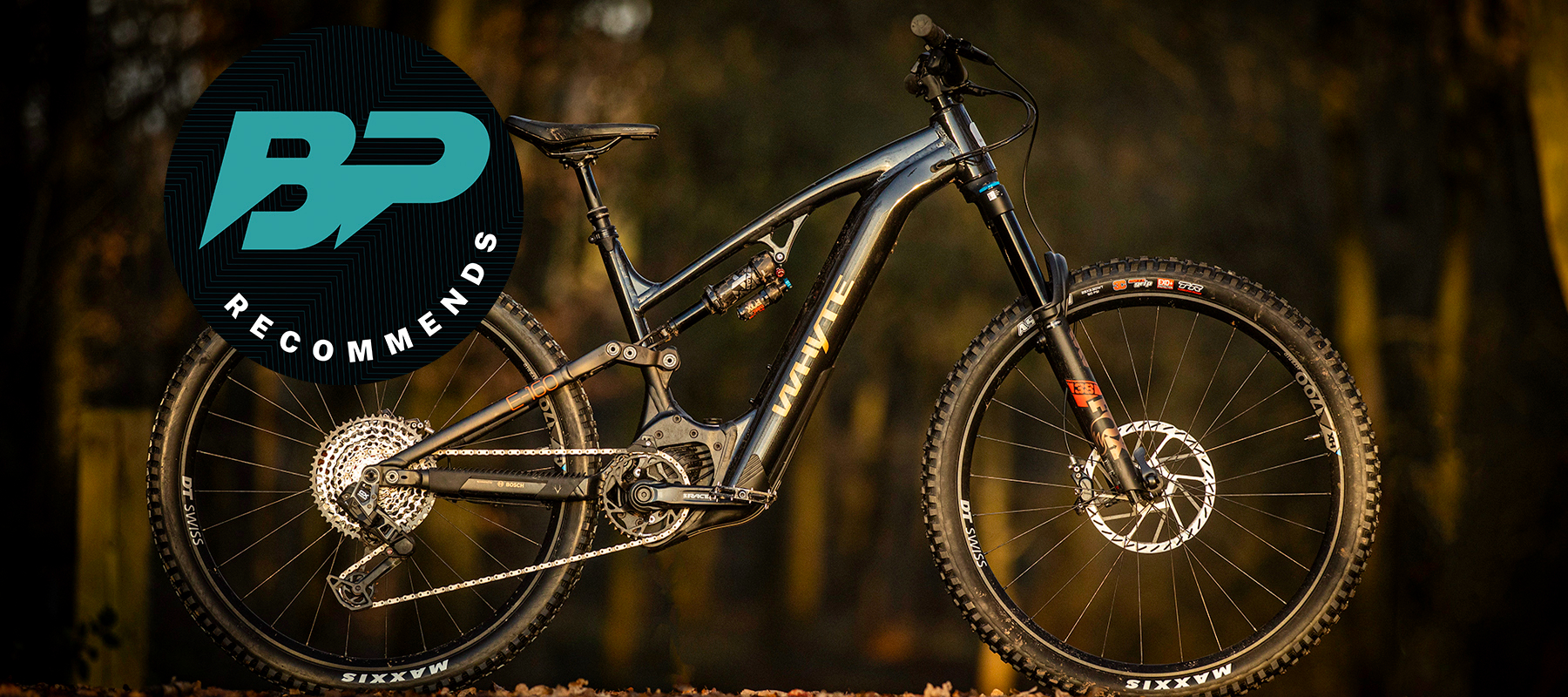Bike Perfect Verdict
With two full fat and two mid-sized motor models with less travel, Whyte’s latest e-MTB line up has all bases covered. With balanced handling and dependable kit, the E-160 was always the brand’s rock-solid all-rounder, and with 29in wheels at both ends, a hefty price reduction and much improved gear, it’s now an even more attractive deal than ever.
Pros
- +
Feels like it always has your back in severe terrain
- +
Stiff, solid and robust
- +
Geometry and rider position is excellent
- +
Meaningful geo adjustment via Shape.It Link flip-chip
- +
GX T-Type Transmission
Cons
- -
Considerably heavier than plenty rivals
- -
Bosch CX bar-mounted remote is easy to damage
- -
Harder to manual, flick around and bunny hop compared to rivals
Why trust BikePerfect
As well as having significantly better kit on board, Whyte’s latest generation E-160 range is significantly better value than last year's model. That’s great news for the consumer and the extra value likely stems (in part, at least) from the recent bike industry turmoil that frequent readers are likely getting as sick of hearing about as us journalists are tired of reporting it.
Like many mid-sized brands, Whyte attracted a big cash injection from an investment group during the pandemic. From the outside, it then looked like the new management tried to improve profit margins and get a quick return, which resulted in Whyte’s prices becoming a fair bit less competitive.
Considering the UK firm previously built its entire reputation on modern geometry, perfect spec lists and top value, this was presumably a bit of a culture shock for retailers and customers used to a set up optimized to sell bikes like this E-160 through real bike shops at prices rivaling online-only brands like Canyon and YT.
The beauty of Whyte’s pre-Covid model was consistently earning good reviews for performance as well as for value, plus the fact you could demo for size with a dealer who could set up, service and help with any later warranty issues. Fortunately, any e-bike failures were less likely than many rivals too, since the Bosch motor and battery setup Whyte use is widely proven as one of the most reliable on the market.
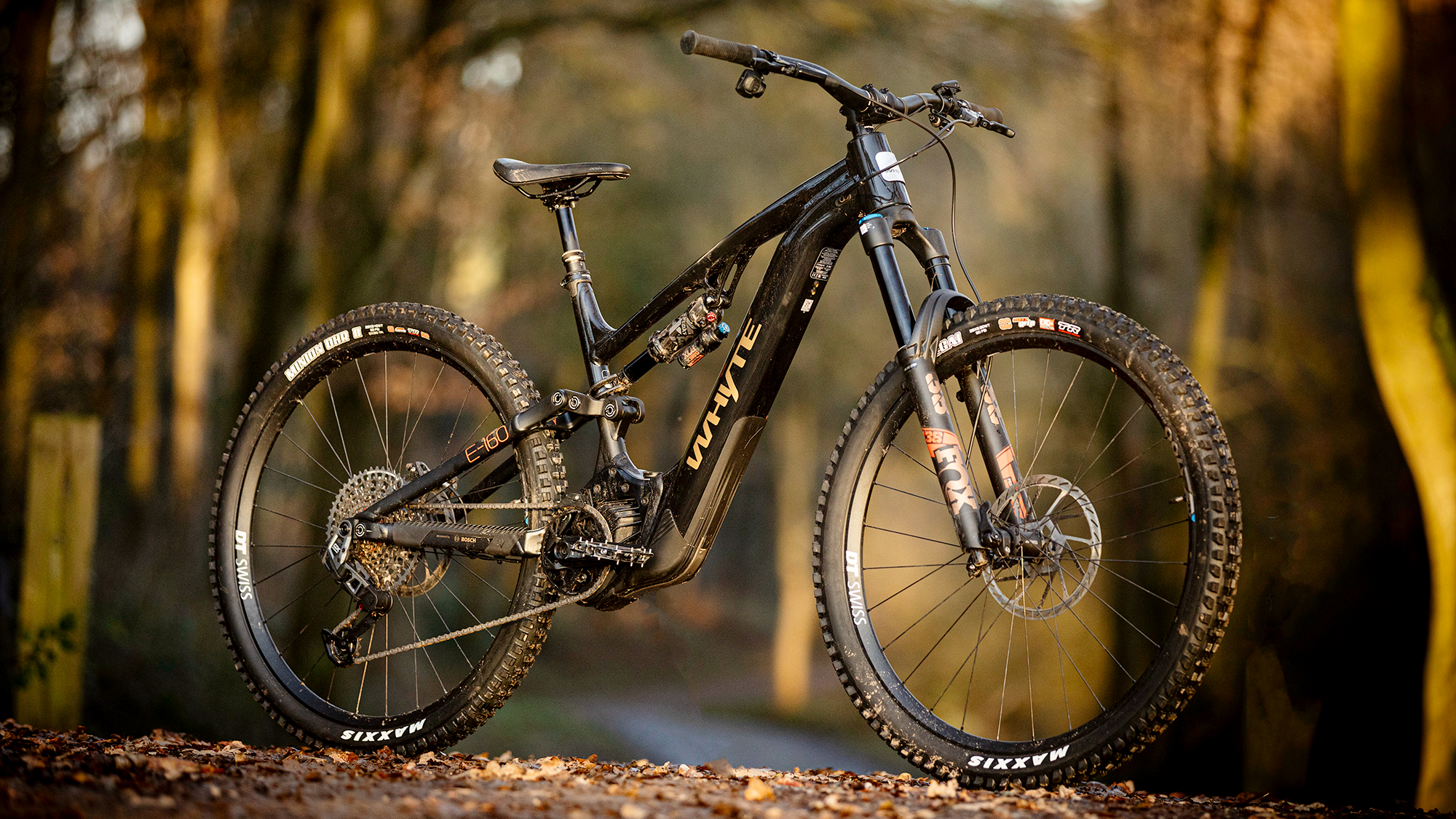
With this latest E-160 (and other models in Whyte’s newly-launched smaller, more focused range), the great news for the public is, with its latest rebrand, it looks like Whyte is shifting back towards its older model of prioritizing value as much as performance.
As a result, this E-160 RSX is a full £1,000 cheaper than last year, and that’s despite a superior, bang up-to-date, specification that retains the best ‘old’ kit like Fox Performance Elite suspension and DT Swiss wheels and bolts on the latest, big-money, bolt-on SRAM GX T-Type Transmission.
Electronic shifting T-Type, just like Bosch’s CX assist system, is known for being extra reliable too, so the 12-speed AXS wireless gears here are perfectly suited to e-MTB abuse with a tougher, rebuildable, modular mech and an extra durable cassette that shifts better under the high loads electric bikes generate.
Elsewhere, Whyte’s proven-tough aluminum chassis, suspension design and geometry largely remain the same, although the brand’s fresh attitude extends to new styling with bolder, simpler graphics and more blocky color schemes.
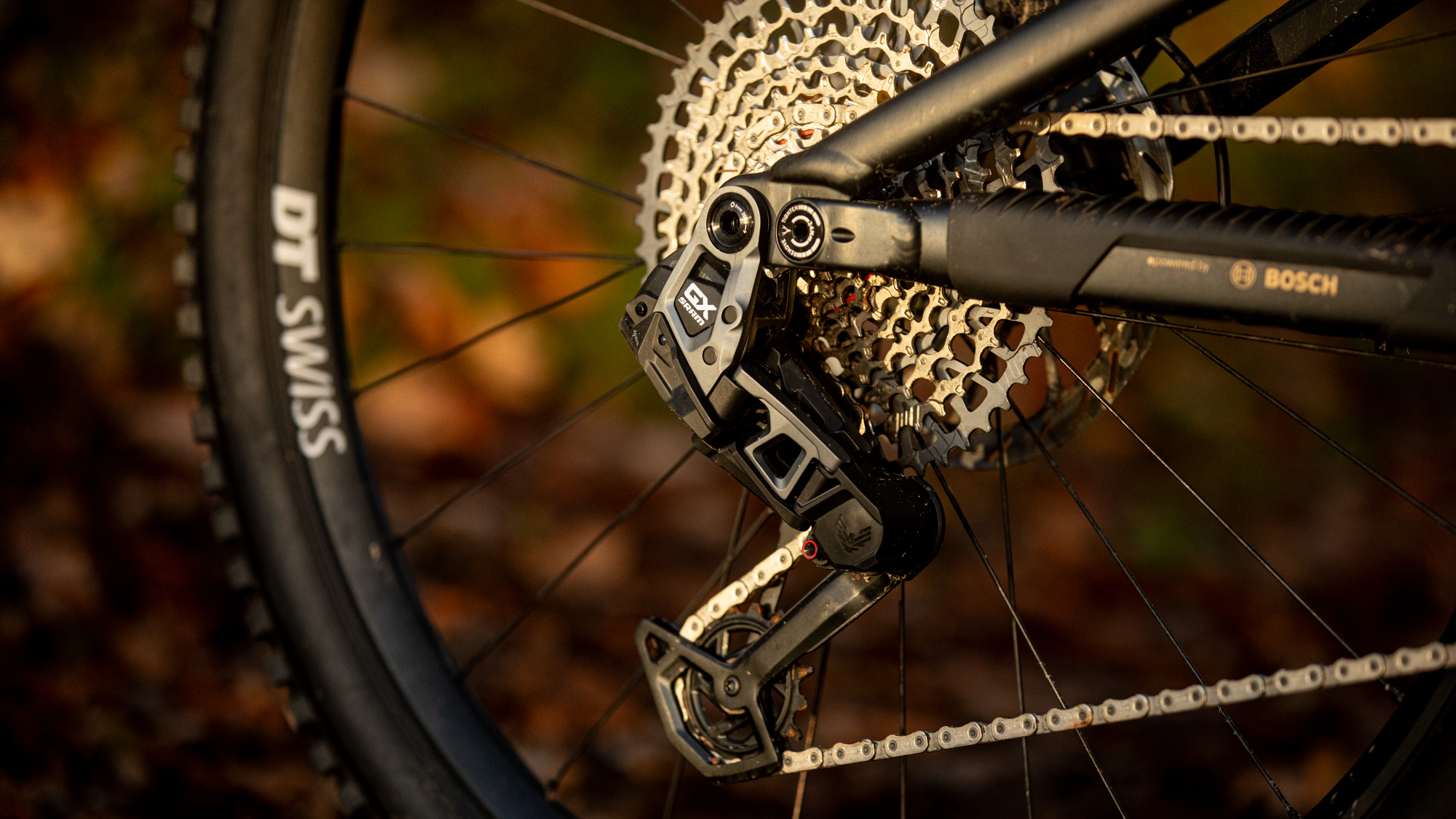
Design and geometry
As mentioned, the bare welded aluminum E-160 bones remain, which means a super tough and chunky frame with a reasonably low standover and 155mm (not 160mm as the name implies) of rear travel. The chassis clearly comes built to last with oversized pivots, chunky forged links and a massive oversized headtube. There is also plenty of frame protection, including rubberized stays and a metal bash rail underneath the battery housing. Being extra beefy does add extra weight though, and the E-160 is pretty hefty at well over 26kg in size Large.
The internal 750Wh (removable for indoor charging) battery lives inside the E-160’s huge downtube in a specially designed slide-in hatch that Whyte refined in the last round of frame revisions. The slick design means Bosch’s big capacity cells are a cinch to take in and out of an internally cavity, and you can’t accidentally drop the heavy battery out of the bike’s belly onto your foot switching like before.
One of the most powerful on the market, Bosch’s premium CX motor has 85Nm of oomph and 600 watts peak power, making it pretty much the benchmark for a ‘mainstream’ drive unit. Look closely and you’ll see it mounted at a twisted angle here, because Whyte has cleverly rotated Bosch’s bulky motor up at the front, to ensure the heaviest component of any e-bike, the battery, can sit lower down underneath and ‘overlap’ the front of the motor.
Optimizing mass like this is a big deal in terms of getting the bike’s centre of gravity as low to the ground as possible, and, as pioneers in this area, Whyte has done considerable work analyzing weight distribution and its effect on ride quality. I personally reckon it’s something noticeable out on the trails too, which I’ll get to later.
The frame uses a four-bar Horst Link suspension design, is multi-butted throughout for strength and built around 29in wheels at both ends, rather than an MX/mullet mixed wheel format on the brand’s longer travel E-180 enduro e-bike.
In terms of frame shape, there are only three RSX sizes available – medium, large and extra-large, although you can get smaller sizes on Whyte’s two cheaper E-160 models. Geometry is contemporary without being extreme, although in the lower setting (a neat Shape.It link on the shock yoke can adjust the geo), the bottom bracket height sinks to 336mm and veers towards extremely low crank-clanging territory for those who don’t keep a close eye on pedaling. The bonus of this super low-slung set up does aid rapid cornering and stability though and might be the sweeter set up for purely DH-focussed riders.
Another benefit of Whyte clocking the motor is slightly more room for the chainstays to sit tighter, which means the 446mm stays here (in all sizes) are pretty short for a full fat e-bike with a bump-swallowing 29in rear wheel. Balancing this is Whyte’s head angle sitting at just a shade over 64-degreee, which pushes the front tire’s contact patch further forward and is pretty slack for any 155mm travel bike, with or without a motor.
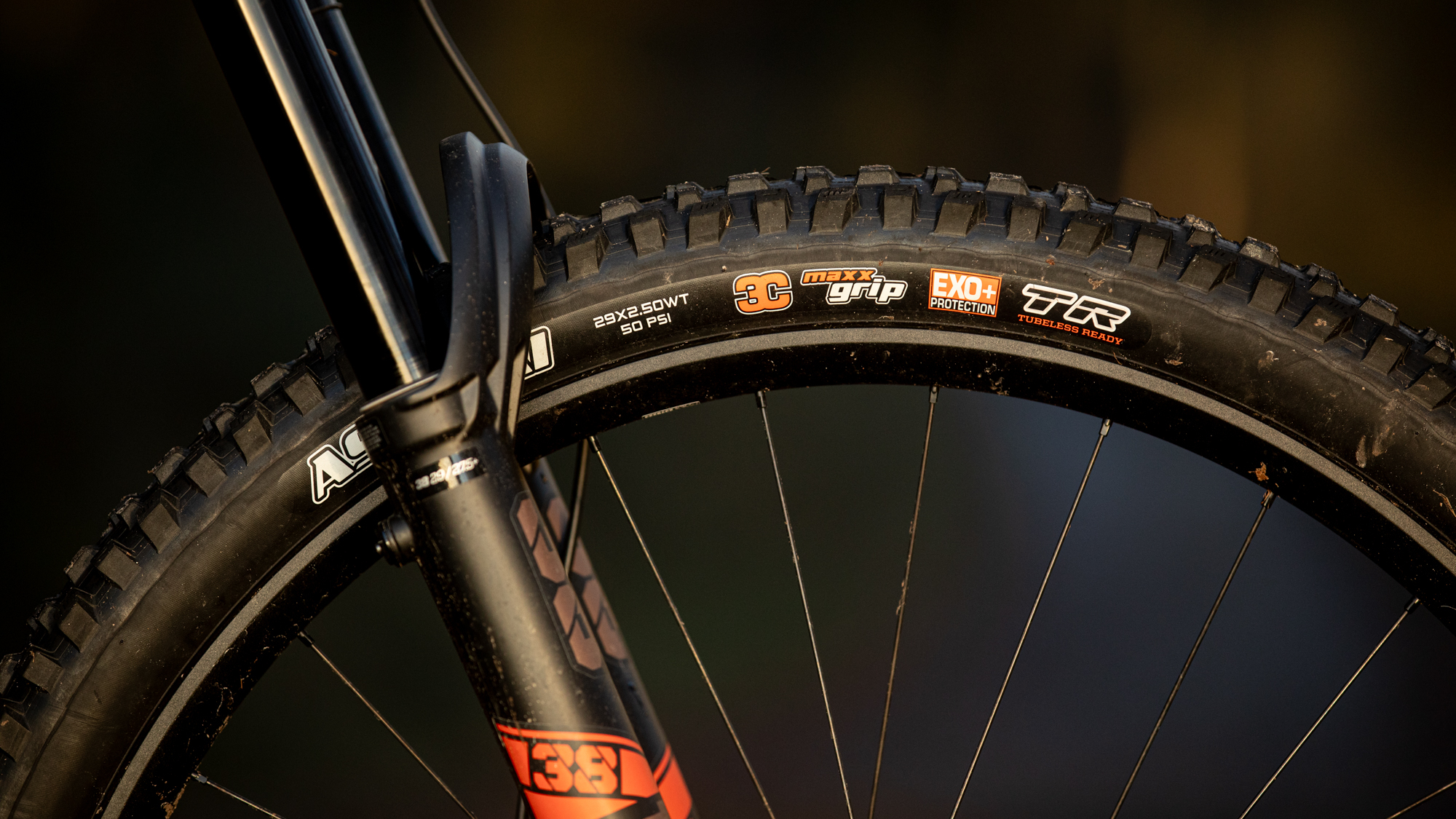
Components and build
Whyte’s RSX kit list reads a bit like a wish list. There’s hardly a beat skipped in the gear, and while seven grand is hardly peanuts, at least Whyte is delivering all the best kit for your cash.
Fox’s suspension is Performance Elite level, which means you get the exact same damping and adjustment as Factory kit, including the GRIP2 four-way adjustable damper in the 160mm forks. PE omits the flashy gold Kashima coating, which isn’t really noticeable in terms of performance and some people (no names) reckon it can look a bit showy too.
The Maxxis tires chosen offer the best treads and compounds for the intended use with a sticky Maxx Grip front, and grippy, but slightly longer lasting and faster rolling rear Maxx Terra. The front is a tough EXO+ casing and rear even tougher dual (120tpi) ply DD to resist damage and cuts, both of which are pretty much ideal for a mid-travel e-bike.
E-160 RSX wheels are DT Swiss HX 1700 and e-bike specific for toughness, as well as being stiffer to better resist braking and drive torque loads from heavier electric machines. Hubs are the latest, proven reliable, DT Swiss 350s with oversized bodies and a ratchet freehub design with 24T. This isn’t DT’s fastest engagement, but looks to durability and keeping you going longer in crud and mud than the absolute fastest pick up.
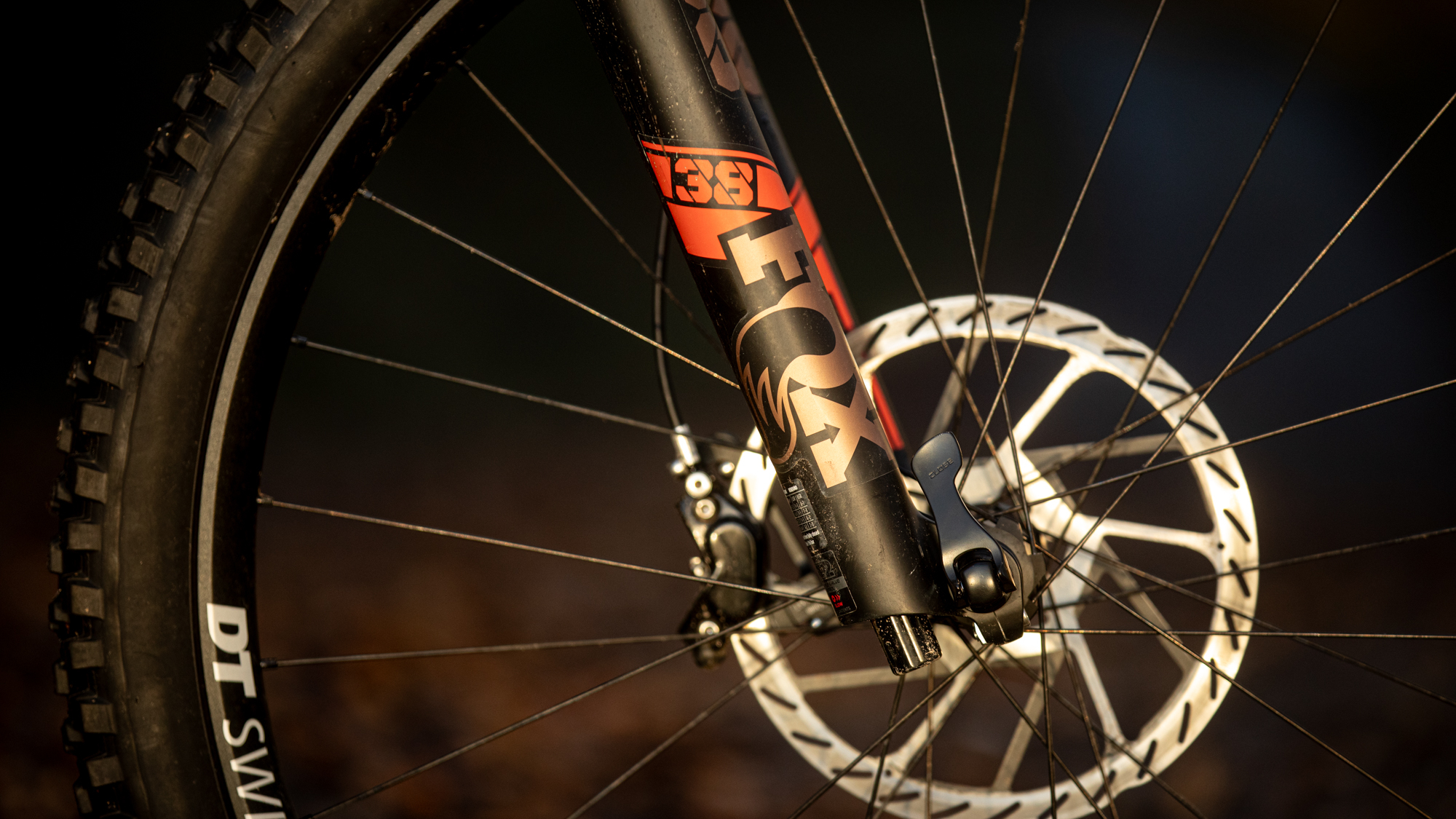
SRAM’s latest T-Type drivetrain is now included, whereas last year’s RSX had the original GX Eagle 12-speed AXS setup. The new system is a big step up in terms of robustness and better at dealing with e-bike shifts under load thanks to a stiffer construction and mounting and extra defined cassette profiles that shift more directly. It doesn’t hurt either that SRAM’s mech is bolted directed to the chassis and axle via the latest UDH interface so it's way harder to damage, and the whole system also uses modular components that mean it can be replaced in pieces if you do have a whoopsy and smash the drivetrain into some rocks.
I really like how positively T-Type shifts slam through under power, how everything feels smooth and solid and SRAM’s new up/down Pod shifters suit me [I concur – Ed], but according to the Internet, not everyone else is in total agreement about those pods.
More tidy SRAM gear comes in the form of top-tier Code RSC brakes that offer a more refined action and superior materials and adjustment to lesser Codes that can get grouchy prematurely. Designed originally as DH brakes, Code RSCs are solid and durable too in my experience, and don’t lack power, even on such a heavy bike. Whyte also specs an oversized, 220mm, front rotor and thicker HS2 rotors at both ends that offer noticeably more bite than SRAMs CentreLine ones.
Other kit pieces include own brand 800mm wide bar (with plenty width to trim if needed) and stem that are nicer finished than many in-house components and a reliable Crank Brothers dropper that comes with 150mm drop on the size Large – less than you’d want on a normal bike maybe, but I found it fine on an e-bike.
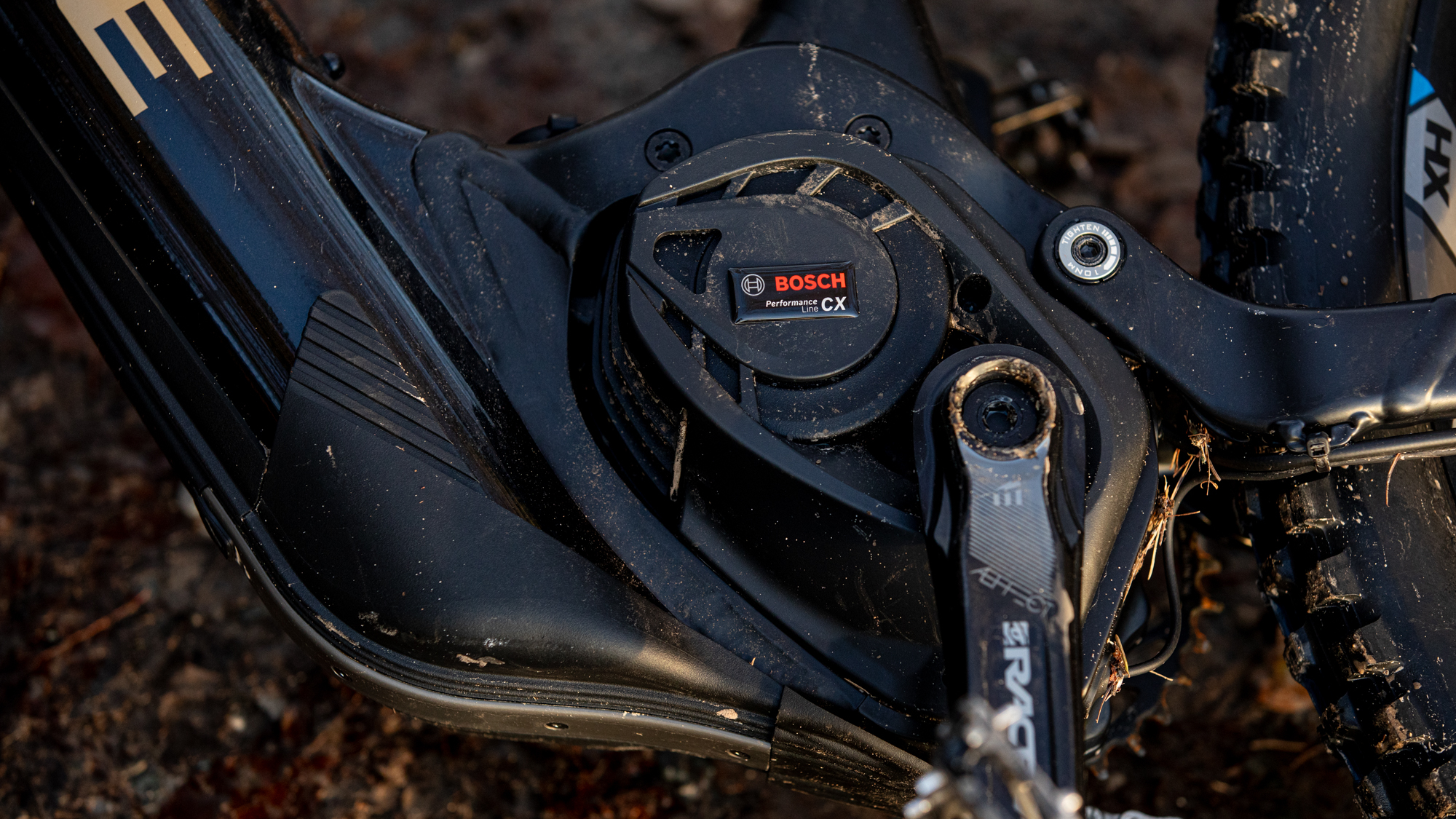
Motor and battery
There’s a strong argument for Bosch’s latest CX motor being the best all-round drive unit in the e-MTB game at the moment. Whyte’s motor has tons of usable power spread across multiple modes including a very seamless ‘intelligent’ e-MTB mode that gives you max assistance when needed and saves power when you don’t. Push on the pedals and power delivery is pretty much instant and there’s a load of overrun (in Turbo mode especially) to help winch up tricky climbing sections or simply blast uphill on extended slopes. Bosch’s motor is also reasonably quiet and there was no rattle here, which can sometimes be an issue on other bikes.
The E-160 frame can accommodate Bosch PowerTube sizes from 500 to 750Wh – if you want to buy extra batteries, Though you can ditch almost a kilo and a half from the bike’s total weight by swapping the stock 750Wh battery here for a 500Wh.
Bosch’s largest 750Wh capacity battery isn’t the absolute biggest on the market, but range is excellent and the power diminishes in a uniform way so you don’t get caught out with one bar meaning you’re nearly dead a long way from home like on a Shimano EP8; something that would be especially galling here, as few people would want without power on a bike that weighs the best part of 27kg.
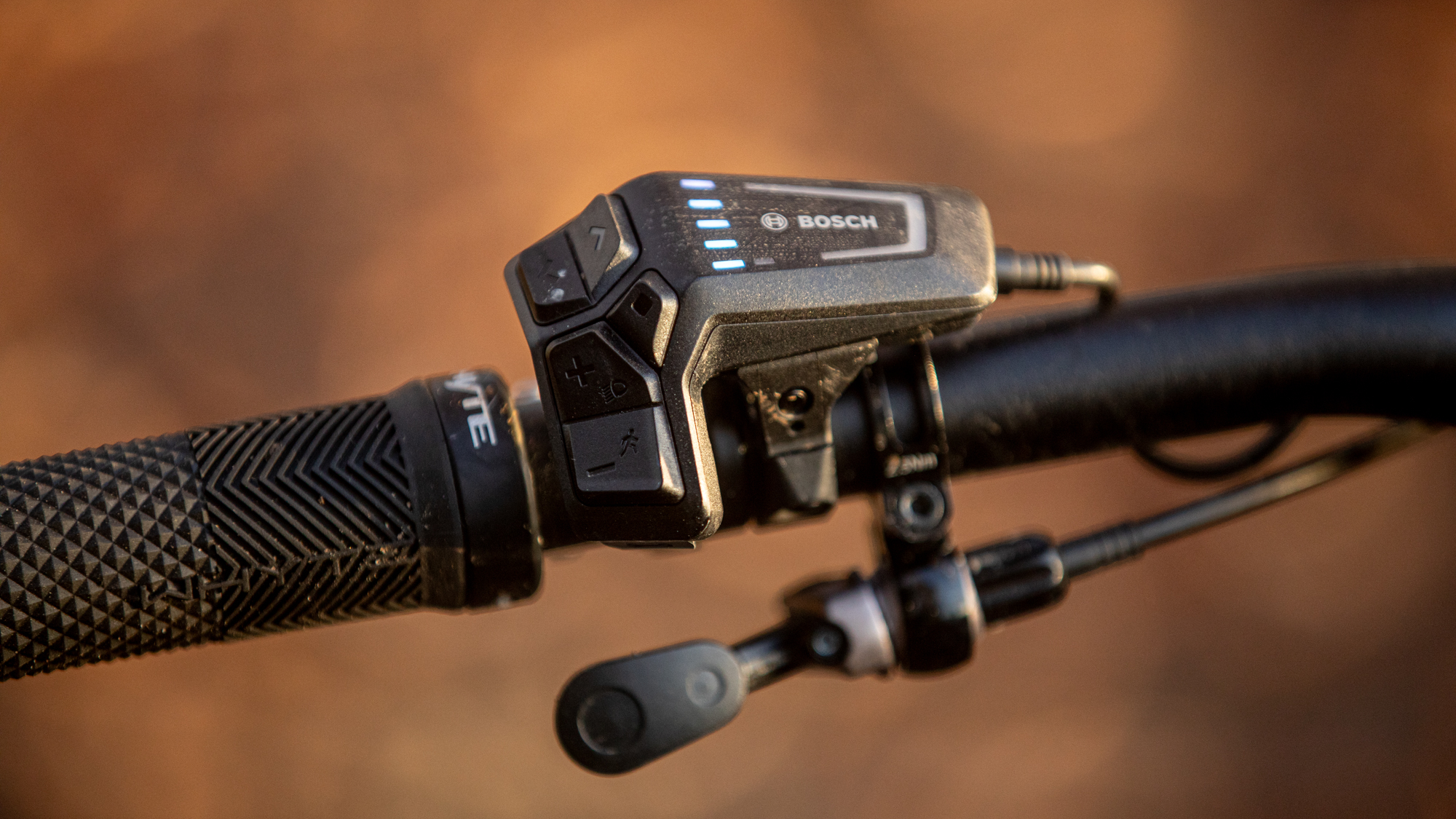
Whyte’s aluminum frame can’t accommodate the latest Bosch System controller in the top tube like a carbon bike can, so you have to put up with extra clutter on the bars and don’t get the neat wireless remote like on Whyte’s new E-Lyte range. I’m not a fan of of the clunky, oversized Purion LED display either, which sticks out and looks ominously ready to be damaged. Some people like all the info-like cadence on a screen while riding, but I’m more than happy with a less-is-more approach, and occasionally checking settings on Bosch’s Flow phone app or whatever, if needed. Bosch also has a smart e-bike Lock function though, which is pretty handy to use your phone as a digital key if you’re briefly leaving an expensive e-bike outside a café or pub on a ride for example.
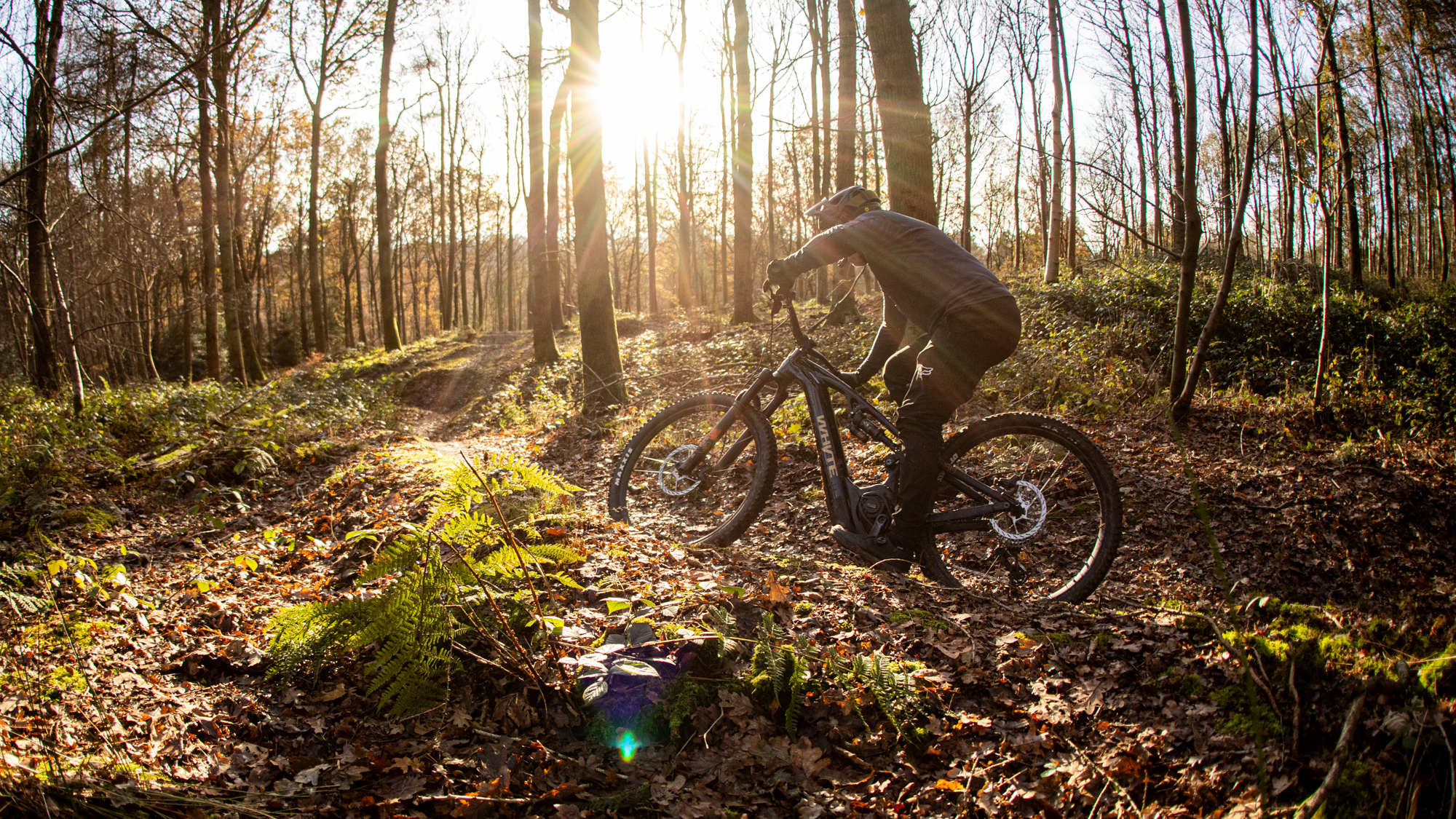
Ride and performance
A one line Whyte E-160 summary might go something like this, ‘If you want one of the best skills compensating machines on the market, look no further’. Few bikes make you feel as safe and assured on any terrain, something I reckon is due to multiple factors converging like the overall weight being high, totally dialled suspension performance and chassis geometry and stiffness. Whyte’s clever positioning of the heaviest parts to be lower down and very centered also plays into the mix too.
The E-160 ‘only’ has 155mm rear travel, but with 29in wheels at both ends, I’ll take some convincing you’d ever need more comfort and isolation at 99 percent of UK riding spots. Downhill capability is so high and cushioning so good, you’d even be hard pressed to tell much difference between this bike and Whyte’s E-180 in terms of suspension depth and absorption.
On all trail surfaces, there’s superb tracking and bump tracing, to the point you wouldn’t be shocked if Whyte’s tyres were coated in Velcro and dipped in honey. Most smaller hits from stones and thin roots don’t even register and the E-160 is so glued to the floor, your body feels like it’s suspended in some kind of slow-motion safety blanket.
You have to seriously screw up sections to get jerked about on top of the bike and ping off things like shiny roots, or even ever notice bodyweight pitching fore and aft. Essentially, whatever the terrain is doing, there’s almost a sense of feeling clipped in, even if, like me, you’ve never used anything but flat pedals for years.
Being so calm and composed affords extra reaction time, which combined with the bike’s suspension being stable and smooth (rather than hyperactive), means nothing bad happens excessively fast. You can then charge harder, go faster in more control and really crack on, especially when pointing downhill. Whyte’s focus on a super low centre of mass means the E-160 wears its heavier weight well and you kind of steer the bike with your feet and it pivots around it’s centre easily with no sense of extra heft pulling you out of shape or deflecting off roots and rocks at weird angles.
The Fox 38 works great (as you’d expect) with precise steering while the front head stock part of the frame feels utterly solid and flex free. Having 5mm more front bounce feels very balanced with the rear, which itself is something of an enigma in dulling impacts and muting vibrations while delivering gobs of grip, yet never feels particularly fast moving or fluid at the shock.
My guess with this is the superb tracking is aided by the overall system weight and chunkiest parts in the middle close to feet and your core weight feeling totally planted, while the relatively lighter wheels can cycle up and down faster – all e-bikes exhibit this sensation, it’s just more pronounced here. I ended up running the rear shock almost wide open on the rebound to get a more poppy ride, which is something the bike’s designer, Sam Shucksmith, told me he also does. Shucksmith also said Whyte are really happy with the damper’s tuning range and the fact more advanced riders can open up the Float X for a livelier feel and heavier/less experienced riders get extra control and composure from settings in the middle of the range.
Bosch’s CX system worked flawlessly throughout testing with zero glitches or hiccups you sometimes get on other drive units and with a ton of power to blast you about the place to lap up the good stuff. The aluminium E-160 being heavier means you don’t absolutely fire up the steepest climbs like on the much lighter carbon Turbo Levo I rode a lot last year, and Whyte’s bike is also very close to the ground, which can lead to more accidental pedal strikes sat down climbing (even more so if you set it in the lowest position). For this reason, most people will prefer the high position for technical climbing or clearance on rolling terrain.
Compared to other different e-bikes I’ve used, the E-160 feels less poppy, ‘bouncy’ and nimble than a Nukeproof Megawatt that also isn’t that light, and has way better poise and spec for your cash than a Trek Rail that shares the same motor. Nukeproof’s suspension is equally dialled, just more lightly damped and open, whereas Trek’s suspension felt worse on repeated hits, and the sizing jumps on the Rail won’t suit everyone - particularly the massive leap between medium and large sizes.
There’s no denying that the E-160 RSX pushing towards 27kg in size Large is at the top end of weight for a mid-travel e-bike at £7K, but it’s a double-edged sword when it combines with deep and controlled suspension into one of the most stable and assured handling e-bikes on the market.
Whyte’s bike genuinely made me feel cocky and happy to try my luck, and that can translate to a ton of fun when riding. After a very wet winter, a lot of my local trails have been axle deep in slime and muck, so for a laugh and an extra challenge, mates and I have been deliberately riding the steepest, nastiest tracks in the mud, and despite tons of moments, I’ve not had a single off or sketchy moment on the Whyte, which speaks to how capable this bike is, and who doesn’t want a faithful companion and safety blanket that flatters their skills in the most challenging conditions?
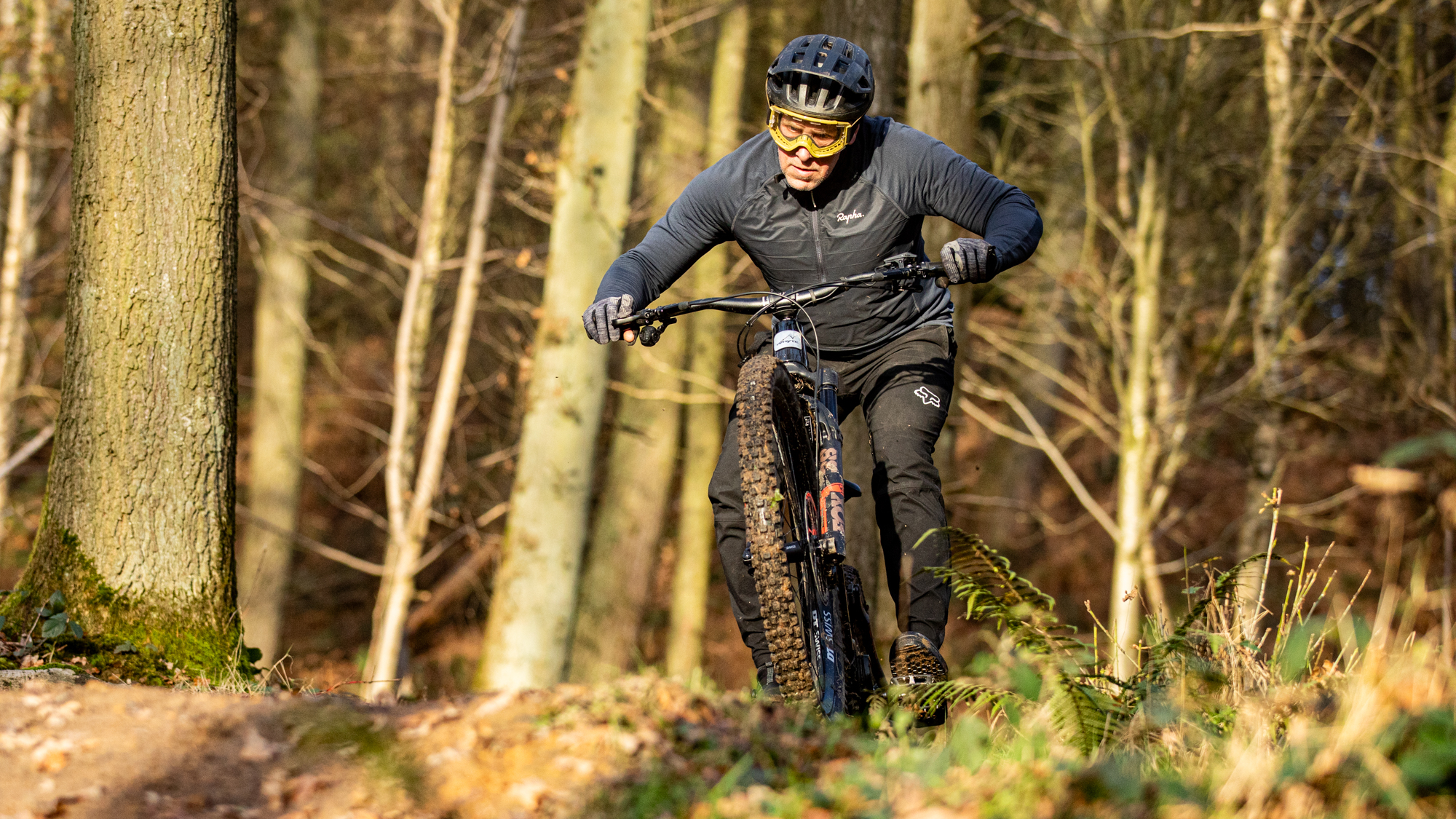
Verdict
Whyte’s E-160 RSX totally nails its remit. This is a rock-solid, tough and reliable machine with a near perfect specification that’s more than capable enough for enduro racing.
The RSX delivers beautifully composed handling and suspension and excels in steep and demanding DH terrain, but being noticeably heavy means it demands some muscle to push it to the limits of its agility. The flipside of this, however, is the E-160 is incredibly stable, assured and easy to steer for anyone and has got your back wherever you end up while maximizing the huge range of Bosch’s sorted CX system.
Test conditions
- Terrain: Local hand-cut trails, armoured trail centre, enduro tracks, small jumps
- Conditions: Slippery/greasy and then deep mud and slop through to bone dry and dusty
- Temperature: Autumn and winter temps 2-14 degrees centigrade
Tech specs: Whyte E-160 RSX 2024
- Price: $TBA / £6,999.99 / €TBA
- Frame: Whyte 6061 alloy T6 aluminium w/Shape-it link. 155mm travel
- Fork: Fox 38 Float Performance Elite 160mm travel
- Shock: Fox Float X Performance Elite DPS EVOL
- Motor: Bosch Performance Line CX 85Nm (600W peak power), 750Wh removable battery
- Head tube angle: 64.2-degrees
- Seat tube angle: 77.5-degrees (effective)
- Reach: 484mm
- Weight: 26.5kg / 58.4lb (size large tested)
- Drivetrain: SRAM GX Eagle T-Type, 12-speed, XS 1275 cassette 10-52T, RaceFace A-Effect 165mm crank w/36T chainring, SRAM AXS Pod shifter 2-button MMX
- Brakes: SRAM Code RSC, 220mm front and 200mm rear HS2 rotors
- Wheels: DT Swiss HX1700 hooked rims w/30mm internal, DT Swiss 350 Boost hubs w/24T steel ratchet
- Tires: Maxxis Assegai EXO+ Maxx Grip front 29 x 2.5in, Maxxis DHR 2 DD Maxx Terra 29 x 2.4in rear
- Seatpost: Crank Brothers Highline 3 150mm travel (XL has 170mm), Highline Ball socket remote
- Saddle: Fizik Terra Aidon Wingflex
- Bars: Whyte custom 6061 alloy 35mm bore, 35mm rise, 800mm width
- Stem: Whyte Enduro 35mm
- Rival products: Nukeproof Megawatt Pro, Trek Rail Gen 4, Canyon Spectral:ON

An ex-elite downhill racer, Mick's been mucking about and occasionally racing mountain bikes for over twenty years. Racing led to photo modelling and testing kit for magazines back in the day, and, nowadays, he's mostly riding enduro-style terrain on conventional and electric bikes. As curious as ever about products and tech, he's as likely to be on the other side of the lens or computer screen rating, reviewing and shooting all the latest gear. Mick's list of regular clients includes Bike Perfect, MBR, MBUK, and most of the leading UK MTB publications at one point or another.
